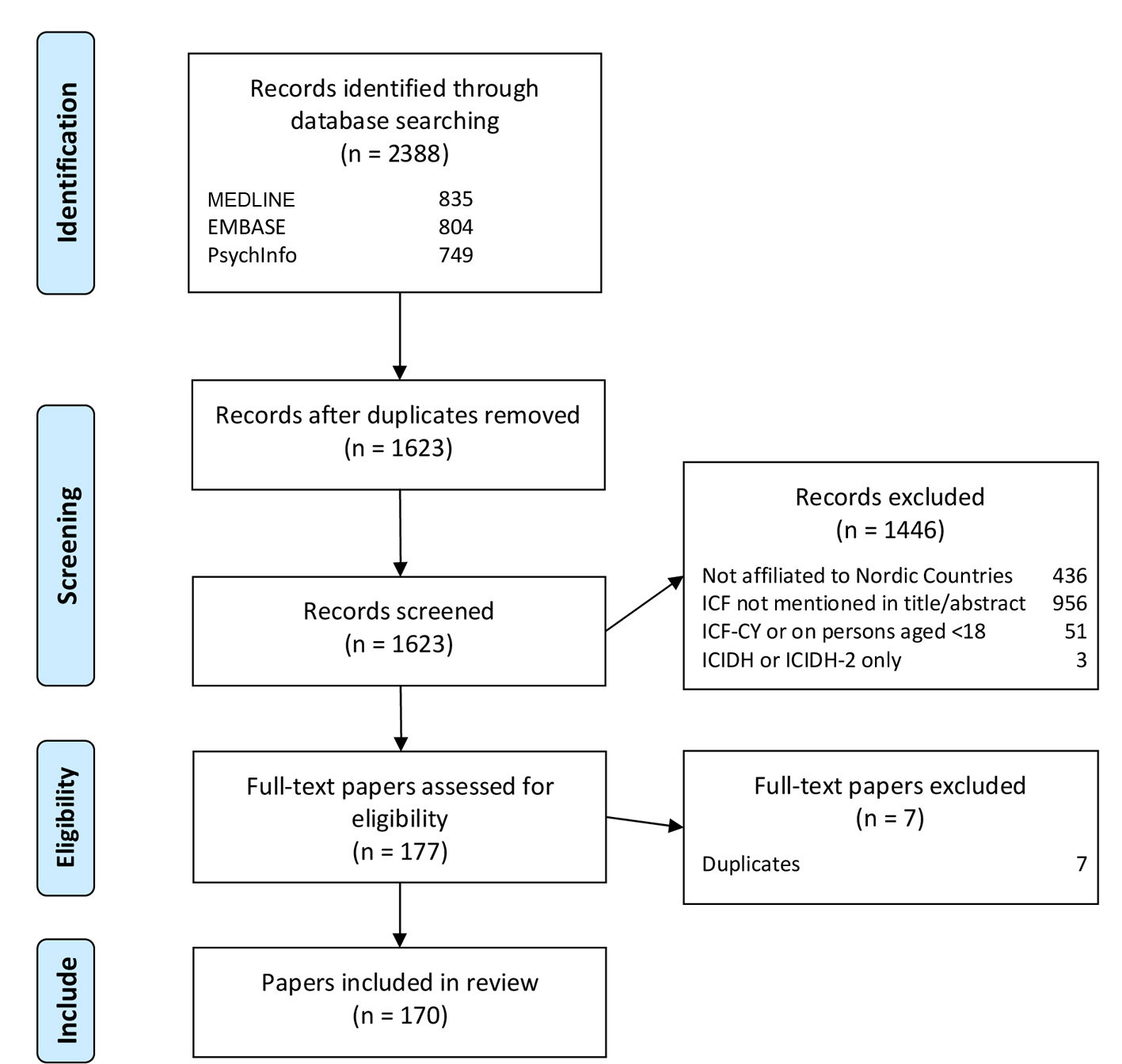
Figure 1. Flow diagram.
| Journal of Clinical Medicine Research, ISSN 1918-3003 print, 1918-3011 online, Open Access |
| Article copyright, the authors; Journal compilation copyright, J Clin Med Res and Elmer Press Inc |
| Journal website http://www.jocmr.org |
Review
Volume 8, Number 1, January 2016, pages 1-9
Systematic Literature Review on ICF From 2001 to 2013 in the Nordic Countries Focusing on Clinical and Rehabilitation Context
Figure

Tables
| Categories/year | 2002 | 2003 | 2004 | 2005 | 2006 | 2007 | 2008 | 2009 | 2010 | 2011 | 2012 | 2013 | Total (%) |
|---|---|---|---|---|---|---|---|---|---|---|---|---|---|
| Clinical and/or rehabilitation contexts | 0 | 1 | 1 | 4 | 4 | 10 | 7 | 10 | 6 | 12 | 14 | 11 | 80 (47.6) |
| Non-clinical contexts | 0 | 0 | 0 | 0 | 3 | 2 | 4 | 1 | 1 | 3 | 3 | 2 | 19 (11.2) |
| Development of ICF and ICF-related instruments | 0 | 0 | 0 | 1 | 3 | 2 | 2 | 4 | 6 | 7 | 5 | 9 | 37 (21.8) |
| Comments and editorials | 1 | 1 | 1 | 1 | 2 | 0 | 1 | 0 | 0 | 0 | 0 | 0 | 7 (4.1) |
| Linking papers | 0 | 0 | 0 | 0 | 0 | 0 | 0 | 0 | 0 | 0 | 1 | 2 | 3 (1.8) |
| ICF only mentioned | 0 | 0 | 0 | 0 | 0 | 1 | 0 | 0 | 0 | 0 | 1 | 0 | 2 (1.2) |
| Protocol | 0 | 0 | 0 | 0 | 0 | 0 | 0 | 0 | 0 | 0 | 1 | 0 | 1 (0.6) |
| Review | 0 | 0 | 1 | 2 | 0 | 1 | 0 | 3 | 2 | 1 | 5 | 6 | 21 (12.4) |
| Total | 1 | 2 | 2 | 6 | 12 | 15 | 13 | 15 | 13 | 23 | 25 | 24 | 170 (100) |
| Country | Total papers (%) | “Clinical and/or rehabilitation contexts” and “non-clinical contexts” papers (%) |
|---|---|---|
| Sweden | 96 (56.5) | 53 (53.5) |
| Norway | 42 (24.7) | 26 (26.3) |
| Finland | 23 (13.5) | 18 (18.2) |
| Denmark | 9 (5.3) | 2 (2.0) |
| Iceland | 0 (0) | 0 (0) |
| Total | 170 (100) | 99 (100) |
| Focus area | Total papers (%) | “Clinical and/or rehabilitation contexts” and “non-clinical contexts” papers (%) |
|---|---|---|
| *Other: oral health, hemophilia, dysphagia, wheelchair users, leg ulcer patients, aphasia, young adults with a disability, education and alcohol dependency. †Not relevant is papers dealing with ICF framework. | ||
| Neurology | 44 (25.9) | 27 (27.3) |
| Musculoskeletal | 31 (18.2) | 15 (15.2) |
| Work-related | 17 (10.0) | 17 (17.2) |
| Rheumatology | 12 (7.1) | 8 (8.1) |
| Mixed population | 10 (5.9) | 3 (3.0) |
| Community dwelling elderly | 7 (4.1) | 5 (5.1) |
| Psychiatry | 7 (4.1) | 4 (4.0) |
| Hearing loss | 6 (3.5) | 3 (3.0) |
| Heart/lung problems | 3 (1.8) | 3 (3.0) |
| Trauma | 3 (1.8) | 3 (3.0) |
| Cancer | 3 (1.8) | 1 (1.0) |
| Pain | 2 (1.2) | 2 (2.0) |
| Torture survivors | 2 (1.2) | 1 (1.0) |
| Other* | 9 (5.3) | 6 (6.1) |
| Not relevant† | 14 (8.2) | 1 (1.0) |
| Total | 170 (100) | 99 (100) |
| Components* | Papers (%) |
|---|---|
| *Components (body functions, body structures, activity, participation, environmental factors, and personal factors) mentioned in results or discussion. | |
| 0 | 11 (11.1) |
| 1 | 5 (5.1) |
| 2 | 9 (9.1) |
| 3 | 18 (18.2) |
| 4 | 29 (29.3) |
| 5 | 27 (27.3) |
| Total | 99 (100) |
| Components* | Papers (%) |
|---|---|
| n = 99. *Components (body functions, body structures, activity, participation, environmental factors, and personal factors) mentioned in results or discussion. | |
| Body functions/body structures | 68 (68.7) |
| Activity | 85 (85.9) |
| Participation | 79 (79.8) |
| Personal factors | 40 (40.4) |
| Environmental factors | 56 (56.6) |